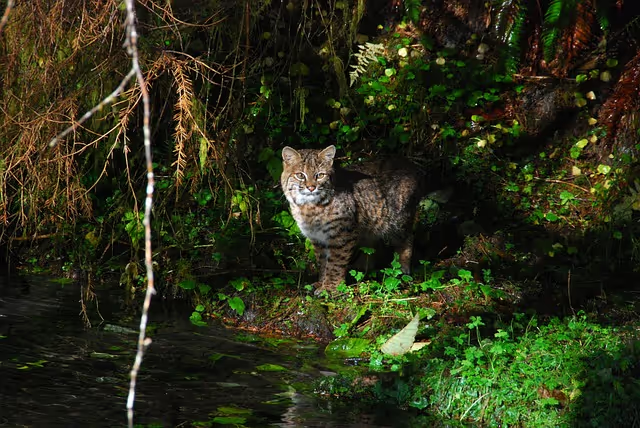Bobcats


Bobcats (Lynx rufus) can be found through most of the contiguous United States, Mexico as far south as Oaxaca, and southern Canada. They are one of four species of lynx found worldwide and one of two native to North America, the other being the Canada lynx (Lynx canadensis). In Washington State, the Canada lynx can only be found in the Cascades, while the bobcat can be found throughout the state. Currently, there are only two subspecies of bobcat recognized: L. r. rufus, which occur east of the Great Plains and L. r. fasciatus, which occur west of the Great Plains (Kitchener et al 2017).
Bobcats are medium sized cats and the smallest of the four lynx species. They can reach 30-48 inches from head to tail, 1.5-2 feet tall, and weigh between 9-33 pounds. Like other lynx species, they have tufts of hair on their ears and ruffs of hair on their cheeks, though theirs are smaller than other members of their genus. They get their common name from their stubby “bobbed” tails. Their fur is brown or buff with brown or black spots and stripes. The tips of their tails and the back of their ears are black while their undersides are white. In the summer, their fur can take on a reddish tinge.
Their tracks are twice the size of a domestic cat and round shaped. They have four toes and retractable claws, therefore their tracks will not have claw marks on them.
They can thrive in a wide variety of habitats, including mountain ranges, boreal and coniferous forests, swamps, bogs, scrubland, and deserts. In order to thrive, they require dense vegetation for cover; adequate prey sources; and rock piles, log piles, rocky ledges, and hollow trees for denning. They will venture into spaces that are more open to hunt if there is cover nearby for them to escape to (WDFW n.d.).
Bobcats are solitary. In western Washington, male bobcats have a home range of 2.6 to 6 square miles while the home range for females is about 1.3 to 3 square miles (WDFW n.d.). They mark their territories by clawing and depositing urine or feces.
Bobcats can be active at any time of the day, though they are usually crepuscular (most active at dawn and dusk). In areas with humans, they will often be more active during the night.
Bobcats prefer preying upon rabbits, hares, and rodents, though they will eat a variety of animals, including birds, small ungulates, small domestic animals, amphibians, and reptiles. Adult bobcats do not have many predators aside from cougars and grey wolves. Juvenile bobcats may be preyed upon by eagles, great horned owls, coyotes, foxes, and bears (Tesky 1995).
Mating can occur between November through August, though when it occurs depends on location and climate conditions. It commonly occurs during late winter/early spring. Gestation is 60-70 days and litters can have up to five kittens. Kittens are raised solely by their mother. The kittens are weaned around 7-8 weeks old, and separate from their mother during their first winter. Females reach sexual maturity at one year of age while males reach it at two years of age. They can live up to fifteen years in the wild.
References
Kitchener, A. C.; Breitenmoser-Würsten, C.; Eizirik, E.; Gentry, A.; Werdelin, L.; Wilting, A.; Yamaguchi, N.; Abramov, A. V.; Christiansen, P.; Driscoll, C.; Duckworth, J. W.; Johnson, W.; Luo, S.-J.; Meijaard, E.; O'Donoghue, P.; Sanderson, J.; Seymour, K.; Bruford, M.; Groves, C.; Hoffmann, M.; Nowell, K.; Timmons, Z.; Tobe, S. (2017). “A revised taxonomy of Felidae: The final report of the Cat Classification Task Force of the IUCN Cat Specialist Group.” Cat News (Special Issue 11): 38–40. Retrieved December 14, 2022, from https://repository.si.edu/bitstream/handle/10088/32616/A_revised_Felidae_Taxonomy_CatNews.pdf?sequence=1&isAllowed=y
Tesky, J. (1995). Lynx Rufus. Fire Effects Information System. Retrieved December 15, 2022, from https://www.fs.usda.gov/database/feis/animals/mammal/lyru/all.html
Kelly , M., Lopez-Gonzalez , C., & Morin, D. (2016, February 11). Lynx rufus. IUCN Red List of Threatened Species. Retrieved December 15, 2022, from https://www.iucnredlist.org/species/12521/50655874
Bobcat. Washington Department of Fish & Wildlife. (n.d.). Retrieved December 15, 2022, from https://wdfw.wa.gov/species-habitats/species/lynx-rufus
Bobcat. Smithsonian's National Zoo. (2022, May 27). Retrieved December 15, 2022, from https://nationalzoo.si.edu/animals/bobcat
Touch whale bones, examine shipwreck artifacts and connect with the coast's living history.

Support our mission, get involved in educational programs, or contribute through donations and volunteering.